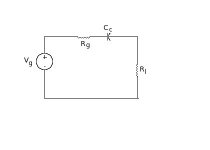Not a prob.
What you have here is basically a high pass filter with a finite zero at w= 0. The pole frequency is:
w0= 1 / (Cc(Rg + Rl)) (w0= 2pif0)
What you need to do is figure out what Rg is, and that'll be basically r(p) || Rp (where Rp is the parafeed plate load at the lowest frequency you want to pass) and, of course, you will need to know what load this preamp will be working into.
What you have here is basically a high pass filter with a finite zero at w= 0. The pole frequency is:
w0= 1 / (Cc(Rg + Rl)) (w0= 2pif0)
What you need to do is figure out what Rg is, and that'll be basically r(p) || Rp (where Rp is the parafeed plate load at the lowest frequency you want to pass) and, of course, you will need to know what load this preamp will be working into.
Attachments
It is. of course, not that easy. The inductance of the parafeed transformer enters into the formula. You can get an estimate of the importance of the inductance by converting it to impedance at a particular frequency. The formula for this is Z = 2piFL where F = frequency and L = inductance. Usually, for parafeed you would do this at 20Hz.
If the inductance is sufficiently high that it is not an issue (the reflected load is much lower), then the above resistive load formula will give you a decent estimate. Otherwise, adjust them for inductance.
This will still only get you close, particularly for a choke load where the choke's own inductance will come into play. Also, there are some weird bass humps that can show up unpredictably. There are a number of simulators you can download to make estimates easier, or you can do what the rest of us do which is buy 20 cheap 1u caps and keep adding more in parallel until it sounds right. Then, buy a good cap in that size.
If the inductance is sufficiently high that it is not an issue (the reflected load is much lower), then the above resistive load formula will give you a decent estimate. Otherwise, adjust them for inductance.
This will still only get you close, particularly for a choke load where the choke's own inductance will come into play. Also, there are some weird bass humps that can show up unpredictably. There are a number of simulators you can download to make estimates easier, or you can do what the rest of us do which is buy 20 cheap 1u caps and keep adding more in parallel until it sounds right. Then, buy a good cap in that size.
- Status
- This old topic is closed. If you want to reopen this topic, contact a moderator using the "Report Post" button.
- Home
- Amplifiers
- Tubes / Valves
- Parafeed dc blocking/coupling cap help
